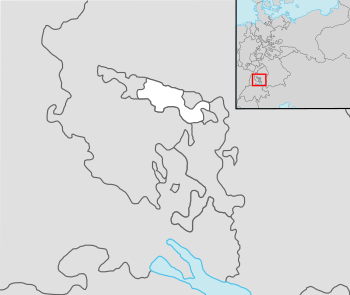Hohenzollern-Hechingen facts for kids
Quick facts for kids
Hohenzollern-Hechingen
|
|||||||||
|---|---|---|---|---|---|---|---|---|---|
| 1576–1850 | |||||||||
|
Motto: Latin: Nihil Sine Deo
(Nothing without God) |
|||||||||

Hohenzollern-Hechingen in 1848
|
|||||||||
| Status | Principality | ||||||||
| Capital | Hechingen | ||||||||
| Common languages | Swabian German | ||||||||
| Religion | Roman Catholic | ||||||||
| Government | Principality | ||||||||
| Historical era | Middle Ages | ||||||||
|
• Partition of County of
Hohenzollern |
1576 | ||||||||
|
• Raised to Principality
|
1623 | ||||||||
|
• House extinction
|
1869 | ||||||||
| 1850 | |||||||||
|
|||||||||
Hohenzollern-Hechingen was a small country in what is now southwestern Germany. It was first a county, then a principality. Its rulers were part of the Hohenzollern family. This family also ruled other parts of Germany, like Prussia.
Hohenzollern-Hechingen was located in the Swabia region. Today, this area is part of the German state of Baden-Württemberg.
Contents
History of Hohenzollern-Hechingen
How Hohenzollern-Hechingen Began
Hohenzollern-Hechingen started in 1576. Before that, it was part of a larger area called the County of Hohenzollern. When the ruler, Charles I of Hohenzollern, died, his lands were divided.
His three sons each got a part:
- Eitel Frederick IV received Hohenzollern-Hechingen.
- Charles II received Hohenzollern-Sigmaringen.
- Christoph received Hohenzollern-Haigerloch.
Unlike some other Hohenzollern family members, the rulers of Hohenzollern-Hechingen remained Roman Catholic.
Becoming a Principality
In 1623, Hohenzollern-Hechingen became more important. It was raised from a county to a principality. This meant its ruler was now a Prince. It was still part of the Holy Roman Empire, a large group of states in Central Europe.
Changes and End of the Principality
In 1806, Hohenzollern-Hechingen joined the Confederation of the Rhine. This was a group of German states allied with Napoleon of France. After Napoleon's defeat, it became a member of the German Confederation in 1815.
In 1848, there were many democratic protests across Europe. These were called the Revolutions of 1848. The Prince of Hohenzollern-Hechingen had to accept a new constitution. This constitution limited his power.
However, the problems between the Prince and the people continued. In 1849, Prince Friedrich Wilhelm Konstantin sold his country. He sold it to his relative, King Frederick William IV of Prussia.
On March 12, 1850, Hohenzollern-Hechingen officially became part of Prussia. Another nearby principality, Hohenzollern-Sigmaringen, also joined Prussia at the same time. These areas were then called the Hohenzollernsche Lande (Hohenzollern Lands).
Rulers of Hohenzollern-Hechingen
Here are the main rulers of Hohenzollern-Hechingen over the years:
Counts of Hohenzollern-Hechingen (1576-1623)
- Eitel Friedrich IV (1576–1605)
- Johann Georg (1605–1623) - He became the first Prince in 1623.
Princes of Hohenzollern-Hechingen (1623-1850)
- Eitel Friedrich V. (1623–1661)
- Philipp Christoph Friedrich (1661–1671)
- Friedrich Wilhelm (1671–1735)
- Friedrich Ludwig (1735–1750)
- Josef Friedrich Wilhelm (1750–1798)
- Hermann (1798–1810)
- Friedrich (1810–1838)
- Konstantin (1838–1850) - He was the last Prince.
Images for kids
See also
 In Spanish: Hohenzollern-Hechingen para niños
In Spanish: Hohenzollern-Hechingen para niños




